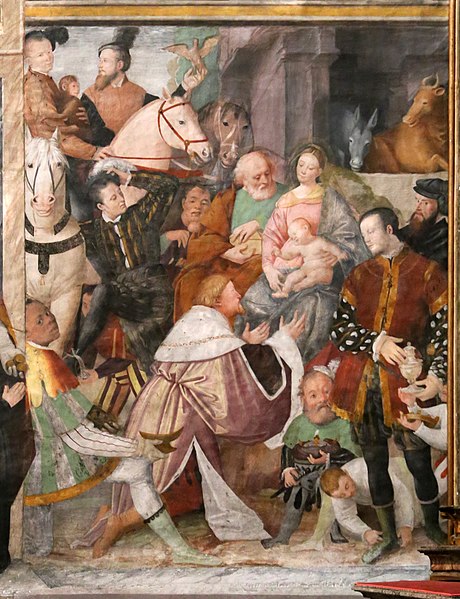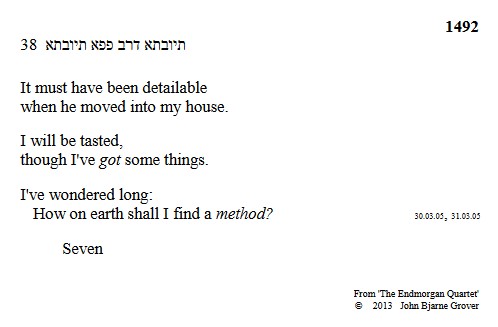
Higher resolutions available here

10 june 2024
John Bjarne Grover
In my article on Gaudenzio Ferrari, under 'example #4' there is a discussion of Ferrari's 'adoration of the magi' relative to my TEQ #1492 which is poem #38 in book 15 'Gentlemen'. An amazing relevance there is in this artwork relative to my poem.

Higher resolutions available here |

|
The parallelism is in three layers: The first two lines are the lower third - the retailers selling boots, for example, and the movement into the 'house'. In the mid layer is Jesus who will be 'tasted' in the last supper later in his life - while he here is getting something, the gifts from the magi. In the upper layer there is the dove who has wandered long, say, from above the heads of the animals to the right to the animals in the mid, and to the left is the monkey who wonders about the (scientific) method. This is all summed up in the signature 'Seven':

Now the interesting aspect is in the hebrew, which I also discuss in that article, although the links now are gone. Notably, the word
תיובתא = vomit, return, answer, reply, refutation, argument, going to and fro, waywardness
is interesting. It is seen how it could be taken to have an interpretation in the lower layer - the dwarf seems to be 'vomiting' the man's coat or jacket upwards, the retailer could be involved in 'return' of the boots, the kneeling magus is involved in answer, reply, refutation, argument - while the legs of the two men to the low left can be seen to perform the fourth sense from Jastrow's dictionary - 'going to and fro, waywardness'.
However, it is seen that the mysterious artwork contains in fact also the elements of the minimal pair (cp. also the detailable/retailable) to the hebrew תיובתא in the form
תיומתא = twin, the central leaf of the palm branch; twin-sister, match, thick thread; molar tooth
The two men just to the left of Josef are 'twinned together' like a thick thread, one of them holds a feather 'leaf' on his 'palm branch', the head, thereby copying the dwarf who also has something like that on his head. There is even a third man who seems to attach something to his boot like the 'retailer' down right. Where is the molar tooth, though? Some people like to philosophize on Jesus as a 'lapis philosophorum' who has dropped down 'ex nihilo' from heaven, which is perhaps not so very interesting. What is it the dwarf holds in his hand? Is it a bird's nest or is it a circle of thick thread like the two men to the left? Whatever the solution to these mysteries, I notice this 'Götterfrucht' story - including the central leaf to the palm branch. Notice also the 'bird' (for the dwarf's bird nest of Ferrari) and the newsmaker's sons - by these news of the birth of Jesus. Even the boots (of my TEQ #681) are there. But where is the molar tooth? Did it fall down from heaven - like Raisi's helicopter on 19 may 2024?
I had equipped the Ferrari article with references to Jastrow's hebrew dictionary - but it seem unfortunately that somebody has made difficulties for this very good online edition which I have used - and which made it possible to very easily look up words and make direct links to them. What happened to this good online edition? I hope it comes on the web again.
Sources:
Ferrari, Gaudenzio: I maestri del colore #133, Fratelli Fabbri Editori, Milano 1966.
Grover, J.: The Endmorgan Quartet. Venice 2008, Vienna 2014.
Jastrow, M.: Dictionary of the Targumim, Talmud Bavli, Talmud Yerushalmi and Midrashic Literature. Judaica Treasury 2004.
Talmud Bavli. Vol.7: Tractate Erubin. Artscroll series, Mesorah Publications 2005.
Talmud Erubin, the classic Vilna edition, El Hamekoroth, Jerusalem 1947/48.
© John Bjarne Grover
On the web 10 june 2024